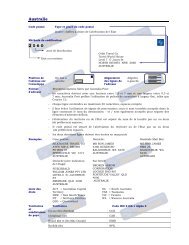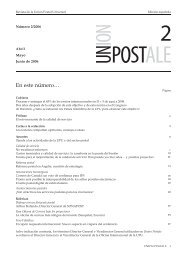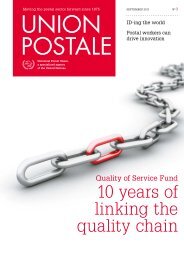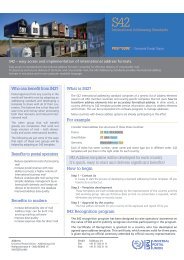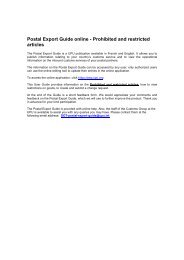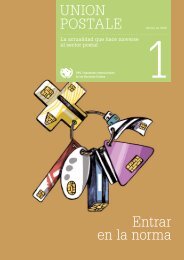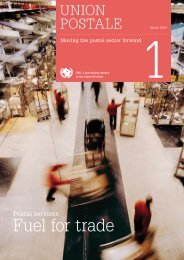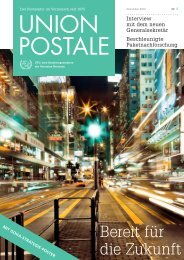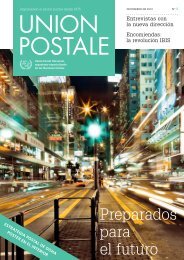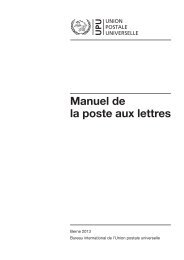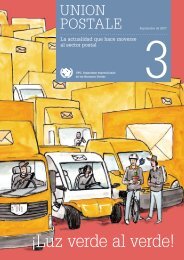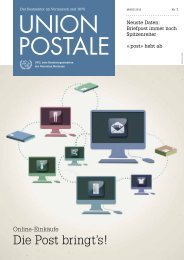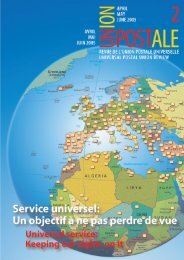Catalogue of UPU Standards - Universal Postal Union
Catalogue of UPU Standards - Universal Postal Union
Catalogue of UPU Standards - Universal Postal Union
You also want an ePaper? Increase the reach of your titles
YUMPU automatically turns print PDFs into web optimized ePapers that Google loves.
S19c<br />
S19d<br />
S20<br />
S22<br />
S23<br />
S23a<br />
Part C: Areas used for postmarks, indicia and service endorsements<br />
Part C provides a formal definition <strong>of</strong> areas used for postmarks, indicia and service endorsements.<br />
These areas can, depending on the circumstances, be used by either the mailer or a postal<br />
handling organisation.<br />
Part D: Areas used for the printing <strong>of</strong> addresses and associated customer applied coding<br />
Part D deals with the definition <strong>of</strong> areas that are, or can be, used for the printing <strong>of</strong> addresses and<br />
customer applied barcodes which are printed together with the delivery address.<br />
Identification and marking using Radio Frequency Identification<br />
Technology – Reference architecture and terminology<br />
Please refer to document S61 for the current standard.<br />
WITHDRAWN<br />
Identification and marking using Radio Frequency Identification Technology – System<br />
requirements and test procedures<br />
This is the second <strong>of</strong> four standards dealing with RFID systems, which can be used to automatically<br />
identify postal items. This standard provides a number <strong>of</strong> definitions, categorisations, and tests in<br />
order to enable users and suppliers <strong>of</strong> <strong>UPU</strong> RFID systems to specify system requirements that<br />
guarantee interoperability.<br />
Radio Frequency Identification (RFID) and Radio Data Capture (RDC) Systems – Air<br />
interfaces: Communications and interfaces<br />
WITHDRAWN<br />
Part A: Definitions <strong>of</strong> parameters to be standardised<br />
WITHDRAWN<br />
Please refer to document S61 for the current standard.<br />
S23b Part B: Parameter values for 5.8 GHz RFID systems WITHDRAWN<br />
NOTE 18000–5 Parameters for Air Interface Communications at 5.8 GHz provided physical layer,<br />
anti-collision system and protocol values for RFID systems for item identification operating at 5.8–<br />
5.9 GHz in accordance with the requirements <strong>of</strong> ISO 18000–1. This standard has been withdrawn.<br />
S23c Part C: Parameter values for 2.45 GHz narrow band RFID systems WITHDRAWN<br />
Please refer to document S61 and ISO/IEC 18000–1 and ISO/IEC 18000–4.<br />
S23e Part E: Parameters for air interface communications at 860 MHz to 960 MHz WITHDRAWN<br />
Please refer to document S61, ISO/IEC 18000–1 and ISO/IEC 18000–6.<br />
S23f Part F: Parameter values for 433 MHz / 125 KHz RFID systems WITHDRAWN<br />
Please refer to document S56 for the current standard.<br />
S23g Part G: Parameter values for 13.56MHz RFID systems WITHDRAWN<br />
S26<br />
S28<br />
Please refer to document S61, ISO/IEC 18000–1 and ISO/IEC 18000–3.<br />
License plates for parcels<br />
This standard defines a <strong>UPU</strong> implementation <strong>of</strong> the ISO 15459 license plate and associated label<br />
for the identification <strong>of</strong> parcels. It provides an open international standards-based identification for<br />
parcels and allows all parties (e.g. customers, Customs, and private transport providers) which<br />
handle a particular parcel to use the same identifier for automatic reading and tracking purposes.<br />
This common identity is useful as an alternative to a more limited identifier assigned by a postal<br />
enterprise.<br />
Communication <strong>of</strong> postal information using two-dimensional symbols<br />
This standard describes the use <strong>of</strong> two-dimensional digital indicia or array codes to convey postal<br />
information in the form <strong>of</strong> symbols printed on postal items, on item or receptacle labels and on<br />
accompanying documentation. The standard is intended for application in all cases in which postal<br />
information and identifiers are encoded, using two-dimensional symbols, on postal items,<br />
receptacles, labels and forms which are exchanged between postal operators. It may also<br />
beneficially be applied in cases in which only a single postal operator is involved.<br />
8 © <strong>UPU</strong> 2014 – All rights reserved



